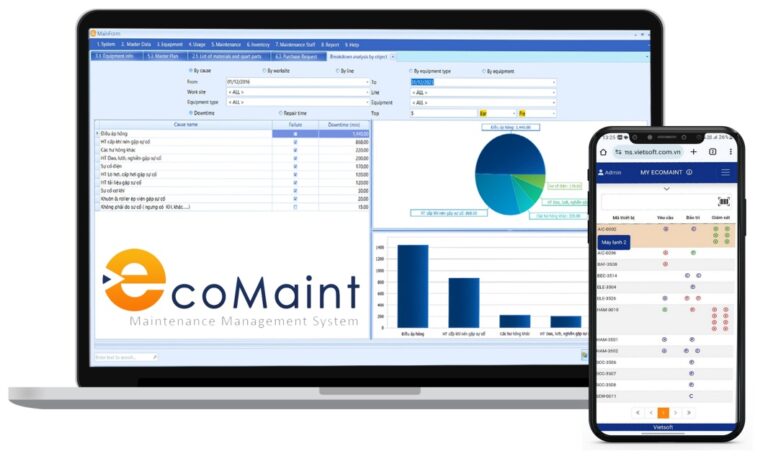
In the dynamic world of industrial
maintenance, understanding why assets fail is crucial for improving
reliability, reducing downtime, and optimizing operational efficiency. Failure
codes in maintenance provide a standardized, systematic way to document and
analyze equipment failures, offering maintenance teams actionable insights to
prevent recurring issues. This comprehensive guide explores the concept of
failure codes, their role in maintenance management, key benefits,
implementation steps, and best practices, all tailored to enhance asset
performance.
I. What Are Failure Codes in Maintenance?
Failure codes in maintenance are alphanumeric
identifiers used to categorize and document the reasons behind equipment or
system failures. Typically integrated into a Computerized Maintenance
Management System (CMMS) like EcoMaint, these codes provide a consistent
framework for recording what went wrong, why it happened, and how it was
resolved. By replacing vague or inconsistent descriptions like “machine
stopped” with precise codes such as “MEC-OVHT” (mechanical overheating),
failure codes enable maintenance teams to track, analyze, and address issues
efficiently.
Failure codes are structured in a hierarchical
framework, often following a Problem-Cause-Action (PCA) model:
- Problem: Describes the observed issue (e.g., “pump won’t start”).
- Cause: Identifies the root cause (e.g., “bearing failure due to
misalignment”).
- Action: Details the resolution (e.g., “replaced bearing” or “realigned
pump”).
This structured approach transforms anecdotal
repair notes into a searchable database, enabling data-driven decisions that
enhance equipment reliability and operational uptime.
II. The Importance of Failure Codes in
Maintenance
Failure codes in maintenance are more than just
labels—they are a cornerstone of proactive maintenance strategies. By
standardizing failure documentation, they provide clarity, improve
communication, and support advanced maintenance methodologies like
Reliability-Centered Maintenance (RCM) and Failure Mode and Effects Analysis
(FMEA). Below are the key reasons why failure codes are indispensable:
1. Identifying Patterns and Recurring Issues
Failure codes allow maintenance teams to aggregate
data and spot trends. For example, if a specific pump model consistently logs
“LEK” (leak) codes, this could indicate a design flaw or improper maintenance
practices, prompting targeted interventions.
2. Enhancing Troubleshooting Efficiency
When a technician encounters a failure, historical
failure codes provide a reference for past issues and solutions. This
accelerates diagnosis and repair, reducing downtime. For instance, a code like
“ELC-SHT” (electrical short) can guide technicians to check wiring or circuit
breakers first.
3. Optimizing Preventive Maintenance
By analyzing failure code data, organizations can
refine preventive maintenance schedules. If “FAT” (fatigue) codes dominate for
a specific component, increasing inspection frequency or upgrading materials
can prevent future failures.
4. Supporting Data-Driven Decisions
Failure codes provide hard evidence to justify
capital expenditures or process improvements. For example, showing that a
machine’s frequent “OVHT” (overheating) failures cost $50,000 annually in
repairs can make a compelling case for investing in a more reliable model.
5. Ensuring Regulatory Compliance
Industries like oil and gas or manufacturing often
face strict regulatory requirements. Standards like ISO 14224 mandate detailed
failure tracking, which failure codes streamline by providing consistent,
auditable records.
6. Improving Team Communication
Failure codes create a common language for
maintenance teams, reducing ambiguity. A new technician can quickly understand
that “VIB” means excessive vibration, regardless of their prior experience.
III. Key Benefits of Using Failure Codes in
Maintenance
Implementing failure codes in maintenance
unlocks several benefits that enhance operational efficiency and asset
longevity. Below are the primary advantages:
1. Standardized Documentation
Failure codes eliminate inconsistent descriptions,
ensuring uniform reporting across teams. This clarity simplifies communication
and improves the accuracy of maintenance records.
2. Increased Maintenance Efficiency
By categorizing failures, codes streamline
troubleshooting and repair processes. Technicians can quickly access relevant
information, allocate resources effectively, and prioritize critical tasks.
3. Proactive Issue Anticipation
Historical failure code data reveals trends,
enabling predictive maintenance. For example, frequent “CAL” (calibration)
codes might prompt recalibration schedules to prevent instrument failures.
4. Detailed Work Order Generation
Failure codes integrate with CMMS platforms to
generate precise work orders, complete with troubleshooting instructions and
repair histories, ensuring technicians have all necessary information.
5. Insightful Reporting
Failure codes enable robust reporting on failure
frequency, costs, and trends. These insights guide strategic decisions, such as
adjusting maintenance schedules or evaluating supplier quality.
6. Regulatory Compliance
For industries subject to standards like ISO 14224,
failure codes simplify compliance by providing structured, auditable data for
inspections and audits.
7. Support for Advanced Maintenance Strategies
Failure codes are integral to RCM, FMEA, and Root
Cause Analysis (RCA), enabling organizations to shift from reactive to
proactive maintenance, reducing downtime and costs.
IV. Common Failure Code Categories and
Examples
To effectively implement failure codes in
maintenance, organizations must develop a code library tailored to their
assets and operations. Below are common failure code categories, along with
examples adapted from industry standards like ISO 14224:
1. Mechanical Failures
- WER (Wear): Normal wear and tear, e.g., worn pump seals.
- FAT (Fatigue): Material failure due to repeated stress, e.g., a
cracked shaft.
- ALG (Alignment Issue): Misaligned components, e.g., misaligned motor
coupling.
- OVH (Overheating): Excessive heat, e.g., bearing overheating due to
insufficient lubrication.
- FRZ (Frozen): Seized components, e.g., a stuck valve.
2. Electrical Failures
- ELC (Electrical Failure): General electrical issues, e.g., a blown
fuse.
- SHT (Short Circuit): Electrical short, e.g., shorted motor wiring.
- OPN (Open Circuit): Broken connection, e.g., a severed control wire.
- SEN (Sensor Fault): Faulty sensor readings, e.g., incorrect pressure
readings.
3. Fluid and Pressure Issues
- LEK (Leak): Fluid or gas leakage, e.g., hydraulic oil leak.
- PLU (Plugged): Flow restriction, e.g., clogged filter.
- PRV (Pressure Relief): Overpressure event, e.g., relief valve
activation.
4. Instrument and Control Issues
- CAL (Calibration Issue): Out-of-calibration instruments, e.g.,
miscalibrated flow meter.
- AIR (Abnormal Instrument Reading): False or inaccurate readings, e.g.,
faulty temperature sensor.
- COM (Communication Fault): Loss of network or signal, e.g., PLC
communication error.
5. Structural and Physical Issues
- COR (Corrosion): Material degradation, e.g., rusted pipe.
- STR (Structural Damage): Physical damage, e.g., cracked equipment
frame.
- BRK (Breakage): Broken components, e.g., shattered gear.
6. Human and Process-Related Issues
- OPS (Operator Error): Incorrect operation, e.g., wrong valve setting.
- MTCE (Maintenance Error): Improper repair, e.g., incorrect reassembly.
- DOC (Documentation Issue): Faulty procedures, e.g., outdated
maintenance manual.
7. External Causes
- PWRFAIL (Power Failure): External power loss, e.g., grid outage.
- ENV (Environmental): Weather-related issues, e.g., flooding damage.
- QCAL (Quality Issue): Defective parts, e.g., premature bearing failure.
8. Action Codes
- REPAIR: Fixed in place, e.g., welded a cracked pipe.
- REPLACE: Swapped with a new component, e.g., replaced motor.
- ADJUST: Fine-tuned settings, e.g., realigned pump.
- LUBRICATE: Applied lubricant, e.g., greased bearings.
- CALIBRATE: Adjusted to standards, e.g., recalibrated sensor.
Below is a sample table of failure codes for a
utility pump, illustrating their application:
|
Code |
Meaning |
Description |
|
FTS |
Fail to Start |
Pump fails to activate on demand |
|
LEK |
Leak |
Fluid leakage from pump seals |
|
VIB |
Vibration |
Excessive vibration during operation |
|
OVH |
Overheating |
Pump temperature exceeds safe limits |
|
PLU |
Plugged |
Blocked flow due to debris |
V. Steps to Implement Failure Codes in
Maintenance
Implementing failure codes in maintenance requires
careful planning to ensure they are effective and adopted by the team. Below
are the key steps:
1. Select a Failure Code Capture Method
Use a CMMS like EcoMaint to capture failure codes
electronically. A robust CMMS ensures consistent data entry, enables powerful
reporting, and mandates code selection before closing work orders.
2. Categorize Data to Collect
Develop a coding structure covering:
- Defects: Observable issues like leaks or vibrations.
- Failures: Root causes like bearing failure or electrical short.
- Interventions: Actions taken, such as repair or replacement.
3. Build a Code Library
Create a concise library of asset-specific codes.
Start with generic codes from standards like ISO 14224, then customize for your
equipment. For example, a conveyor system might include codes like “BELT-MISAL”
(belt misalignment) or “MTR-OVHT” (motor overheating).
4. Train Employees
Educate technicians on the purpose and use of
failure codes. Provide accessible code libraries, ideally via mobile devices,
and make code entry mandatory in the CMMS workflow.
5. Validate with In-House Expertise
Involve experienced technicians in code development
to ensure relevance and buy-in. Their insights ensure codes reflect real-world
failure modes.
6. Analyze and Optimize
Regularly review failure code data to identify
trends, refine codes, and improve maintenance strategies. For example, frequent
“COR” (corrosion) codes might prompt a switch to corrosion-resistant materials.
VI. Best Practices for Failure Codes in
Maintenance
To maximize the effectiveness of failure codes
in maintenance, follow these best practices:
1. Design Asset-Specific Codes
Tailor codes to specific assets or asset classes to
reduce ambiguity. For example, a centrifugal pump might have codes like
“IMP-WER” (impeller wear) that are irrelevant to other equipment.
2. Keep Codes Concise
Limit the code library to 20-30 codes per asset to
avoid overwhelming technicians. Overly complex lists lead to misuse or reliance
on generic “OTH” (other) codes.
3. Mandate Code Usage
Configure the CMMS to require failure code entry
before closing work orders. This ensures consistent data collection and
reinforces the habit.
4. Align with Industry Standards
Consult ISO 14224 or SAE JA1011 for standardized
failure modes and naming conventions. This ensures compatibility with industry
practices and eases onboarding for new technicians.
5. Leverage CMMS Features
Use CMMS features like cascading dropdowns or
NLP-based code suggestions to simplify code selection. For example, EcoMaint’s
intuitive interface allows technicians to quickly select relevant codes.
6. Regularly Update Codes
Conduct annual reviews to add, remove, or refine
codes based on usage patterns and feedback. Eliminate unused codes and add new
ones for emerging failure modes.
7. Integrate with Broader Strategies
Use failure code data to support RCM, FMEA, and
RCA. For example, analyzing “VIB” (vibration) codes across a fleet of motors
can inform vibration analysis programs.
8. Encourage Team Buy-In
Involve technicians in code development and provide
training to highlight benefits, such as faster troubleshooting and reduced
downtime.
VII. Trends in Failure Codes and Maintenance
Technology
As maintenance technology evolves, failure codes
in maintenance are becoming more sophisticated. Key trends include:
1. Integration with IoT and Predictive Maintenance
IoT sensors can automatically generate failure
codes based on real-time data, such as detecting “VIB” (vibration) anomalies
before a failure occurs. This supports predictive maintenance, reducing
unexpected downtime.
2. AI and Machine Learning
AI-powered CMMS platforms like EcoMaint use machine
learning to suggest failure codes based on work order descriptions, improving
accuracy and reducing manual entry errors.
3. Mobile Accessibility
Modern CMMS solutions provide mobile apps, allowing
technicians to enter failure codes on-site, ensuring real-time data capture and
accessibility.
4. Data Analytics and Visualization
Advanced CMMS platforms offer dashboards and Pareto
charts to visualize failure code trends, helping managers prioritize
maintenance efforts.
VIII. How EcoMaint Enhances Failure Code
Management
Implementing failure codes in maintenance is
seamless with a robust CMMS like EcoMaint, developed by Vietsoft, a leading
provider of maintenance management solutions in Vietnam. EcoMaint streamlines
failure code capture, storage, and analysis, empowering maintenance teams to
achieve operational excellence. Key features include:
- Customizable Code Libraries: Create asset-specific failure codes tailored
to your operations.
- Mandatory Code Entry: Ensure consistent data collection by
requiring codes before closing work orders.
- Advanced Reporting: Generate insights on failure trends, costs,
and frequencies to optimize maintenance strategies.
- Mobile Access: Allow technicians to enter codes on-site via mobile devices,
improving efficiency.
- Integration with IoT: Automatically capture failure codes from IoT
sensors for predictive maintenance.
Curious about how
EcoMaint can transform your maintenance operations? Explore the CMMS EcoMaint solution here.
Contact us for consultation via hotline: 0986778578 or
email: sales@vietsoft.com.vn.
IX. Conclusion
Failure codes in maintenance are a powerful tool
for transforming reactive repairs into proactive strategies. By standardizing
failure documentation, they enable maintenance teams to identify trends,
optimize preventive maintenance, and reduce downtime. When paired with a robust
CMMS like EcoMaint, failure codes become a cornerstone of data-driven
maintenance, driving efficiency and reliability. By following best
practices—such as designing concise, asset-specific codes, mandating their use,
and regularly optimizing the code library—organizations can unlock the full
potential of failure codes. Embrace this approach to turn maintenance
challenges into opportunities for continuous improvement.




